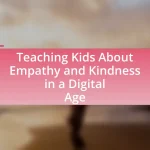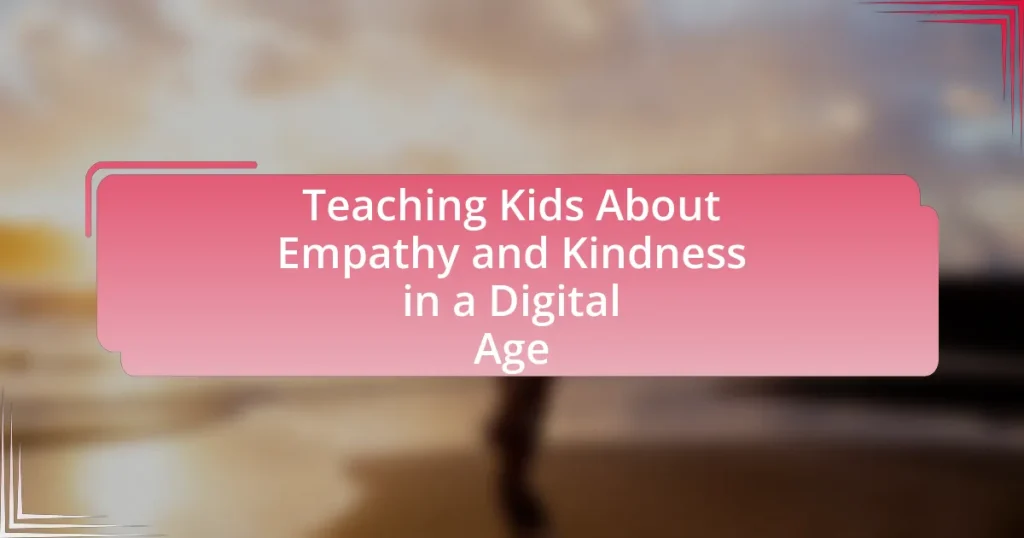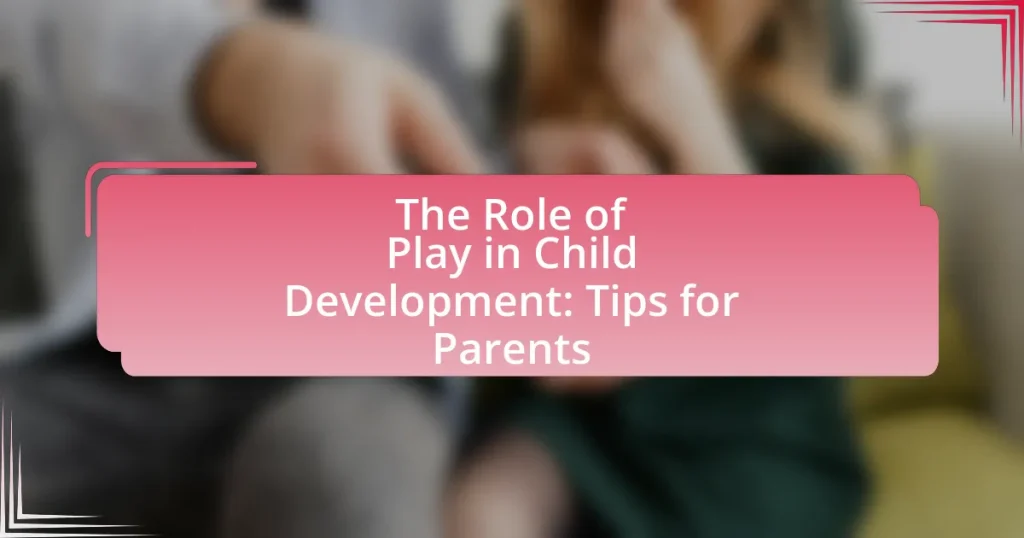Teaching kids about empathy and kindness in a digital age is essential as children increasingly interact through digital platforms, where emotional nuances can be lost. This article explores the importance of empathy for children’s social interactions, the impact of digital communication on their understanding of emotions, and the role of kindness in reducing cyberbullying. It also discusses strategies for parents and educators to foster these values, including the use of technology, storytelling, and community service projects. Additionally, the article highlights the challenges children face in developing empathy online and provides resources for measuring the effectiveness of empathy and kindness education.
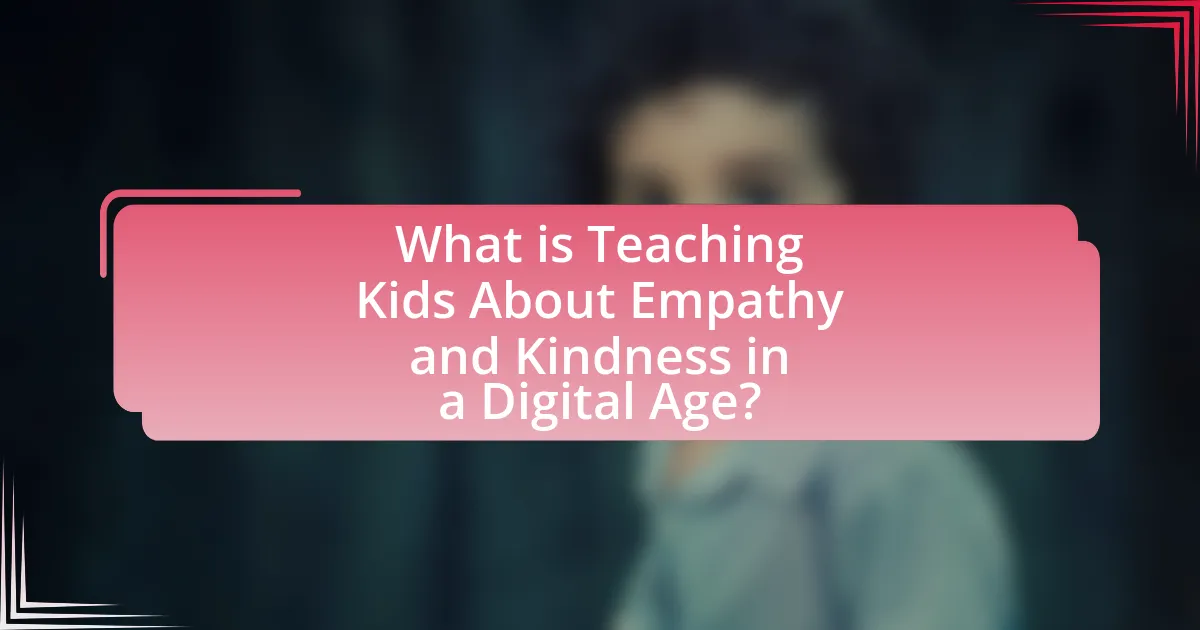
What is Teaching Kids About Empathy and Kindness in a Digital Age?
Teaching kids about empathy and kindness in a digital age involves educating them on understanding and sharing the feelings of others while promoting positive interactions online. This education is crucial as children increasingly engage with digital platforms, where communication can often lack the emotional nuance present in face-to-face interactions. Research indicates that children who learn empathy and kindness are more likely to develop strong social skills and maintain healthier relationships. For instance, a study published in the Journal of Applied Developmental Psychology found that empathy training can significantly enhance children’s prosocial behaviors, which are essential for navigating the complexities of online interactions.
Why is empathy important for children in today’s digital world?
Empathy is crucial for children in today’s digital world because it fosters healthy social interactions and emotional intelligence. In an environment where online communication often lacks non-verbal cues, children who develop empathy can better understand and respond to the feelings of others, reducing instances of cyberbullying and promoting kindness. Research indicates that empathetic children are more likely to engage in prosocial behaviors, which are essential for building positive relationships and community engagement. For example, a study published in the Journal of Youth and Adolescence found that empathy is linked to lower levels of aggression and higher levels of altruism among adolescents, highlighting its importance in navigating the complexities of digital interactions.
How does digital communication impact children’s understanding of empathy?
Digital communication significantly influences children’s understanding of empathy by altering their social interactions and emotional experiences. Research indicates that children who engage in digital communication often miss non-verbal cues, such as facial expressions and tone of voice, which are crucial for developing empathetic skills. A study published in the journal “Computers in Human Behavior” by Przybylski and Weinstein (2019) found that excessive screen time correlates with lower levels of empathy among children, suggesting that reliance on digital platforms may hinder their ability to connect emotionally with others. Furthermore, digital communication can create a sense of distance, making it easier for children to engage in negative behaviors, such as cyberbullying, which further complicates their understanding of empathy.
What role does kindness play in children’s social interactions online?
Kindness plays a crucial role in children’s social interactions online by fostering positive communication and reducing instances of cyberbullying. When children engage in kind behaviors, such as offering support or encouragement, they contribute to a more inclusive and respectful online environment. Research indicates that children who practice kindness online are more likely to develop strong social skills and emotional intelligence, which are essential for healthy relationships. For example, a study published in the Journal of Adolescent Health found that acts of kindness can significantly decrease feelings of loneliness and increase overall well-being among children in digital spaces.
How can parents and educators foster empathy and kindness in children?
Parents and educators can foster empathy and kindness in children by modeling compassionate behavior and creating opportunities for children to practice these values. Research indicates that children learn social behaviors through observation; thus, when adults demonstrate empathy in their interactions, children are more likely to emulate these actions. Additionally, structured activities such as community service projects or role-playing scenarios can provide practical experiences that reinforce the importance of kindness and understanding others’ feelings. Studies show that engaging in such activities not only enhances children’s emotional intelligence but also promotes a sense of belonging and community, which are crucial for developing empathetic individuals.
What strategies can be used to teach empathy through digital platforms?
To teach empathy through digital platforms, interactive storytelling and role-playing games can be effectively utilized. These strategies engage users in scenarios that require them to consider others’ perspectives and emotions, fostering a deeper understanding of empathy. Research indicates that interactive experiences, such as those found in digital games, can enhance emotional intelligence by allowing participants to navigate complex social situations and make choices that affect others’ outcomes. For instance, a study by the University of Southern California found that players of empathy-focused games showed increased empathetic responses in real-life situations.
How can storytelling enhance children’s understanding of kindness?
Storytelling enhances children’s understanding of kindness by providing relatable narratives that illustrate empathetic behavior and moral lessons. Through characters and situations, children can observe the consequences of kind actions, fostering emotional connections and understanding. Research indicates that stories featuring altruistic characters can significantly increase children’s prosocial behavior, as demonstrated in a study published in the journal “Child Development,” where children exposed to stories about kindness were more likely to engage in helpful behaviors themselves. This narrative approach not only teaches the value of kindness but also allows children to internalize these lessons through emotional engagement and reflection.
What challenges do children face in developing empathy and kindness online?
Children face significant challenges in developing empathy and kindness online due to the lack of face-to-face interaction, which diminishes emotional cues. This absence of non-verbal communication makes it harder for children to interpret feelings and respond appropriately, leading to misunderstandings and a potential increase in negative interactions. Additionally, the anonymity of online platforms can encourage aggressive behavior, as children may feel less accountable for their actions. Research indicates that online bullying is prevalent, with 36% of students experiencing cyberbullying, which can further hinder the development of empathy. Furthermore, the constant exposure to curated online personas can create unrealistic expectations and foster feelings of inadequacy, making it difficult for children to engage in kind behaviors towards others.
How does cyberbullying affect children’s ability to empathize?
Cyberbullying significantly diminishes children’s ability to empathize. Research indicates that children who experience or witness cyberbullying often develop a reduced capacity for empathy due to desensitization and emotional numbing. A study published in the journal “Computers in Human Behavior” found that victims of cyberbullying reported lower levels of empathy and increased aggression, suggesting that exposure to online harassment can impair emotional understanding and responsiveness. This decline in empathetic skills can hinder children’s social interactions and their ability to form healthy relationships, ultimately affecting their emotional development.
What are the risks of desensitization in digital interactions?
Desensitization in digital interactions can lead to a diminished emotional response to real-world suffering and violence. This phenomenon occurs as individuals, particularly children, are repeatedly exposed to graphic content online, which can normalize aggressive behavior and reduce empathy. Research indicates that frequent exposure to violent media can result in increased aggression and a lack of concern for others’ feelings, as evidenced by studies showing that children who consume violent video games exhibit less empathy towards victims of bullying. Furthermore, desensitization can hinder the development of social skills necessary for healthy interpersonal relationships, as individuals may struggle to connect emotionally with peers.
How can technology be leveraged to promote empathy and kindness?
Technology can be leveraged to promote empathy and kindness by utilizing digital platforms that facilitate communication and understanding among individuals. For instance, social media campaigns that highlight personal stories of kindness can foster emotional connections and encourage positive interactions. Research shows that online empathy-building programs, such as those developed by the University of Michigan, have been effective in increasing empathetic responses among participants. Additionally, virtual reality experiences that simulate the challenges faced by others can enhance perspective-taking, leading to greater compassion. These technological tools create opportunities for individuals, especially children, to engage with diverse perspectives, ultimately nurturing a culture of empathy and kindness in a digital age.
What apps or tools are effective in teaching empathy to kids?
Apps and tools effective in teaching empathy to kids include “Empathy Toy,” “The Kindness Curriculum,” and “Breathe, Think, Do with Sesame.” The Empathy Toy encourages children to communicate and collaborate, fostering understanding of others’ perspectives. The Kindness Curriculum is a comprehensive program that integrates social-emotional learning with empathy-building activities. Breathe, Think, Do with Sesame helps children manage emotions and develop problem-solving skills, promoting empathetic responses. These tools are supported by educational research indicating that structured programs can significantly enhance children’s empathetic skills and emotional intelligence.
How can virtual reality experiences enhance emotional understanding?
Virtual reality experiences can enhance emotional understanding by immersing users in scenarios that evoke empathy and emotional responses. This immersive technology allows individuals to experience situations from different perspectives, fostering a deeper connection to the emotions of others. Research conducted by the University of Barcelona demonstrated that participants who engaged in virtual reality simulations reported increased empathy levels, as they could visualize and feel the experiences of others in a more tangible way. This ability to step into someone else’s shoes can significantly improve emotional intelligence and understanding, particularly in educational settings focused on teaching empathy and kindness.
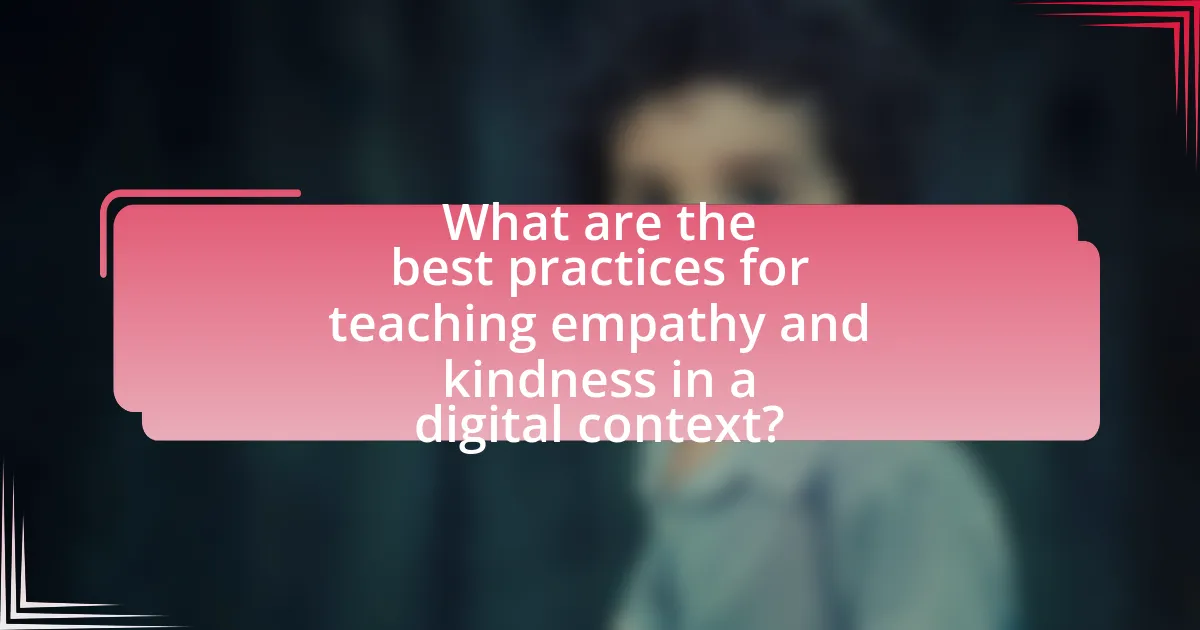
What are the best practices for teaching empathy and kindness in a digital context?
The best practices for teaching empathy and kindness in a digital context include modeling positive online behavior, encouraging open discussions about feelings, and integrating empathy-building activities into digital platforms. Educators and parents should demonstrate respectful communication and active listening in their own online interactions, as children often emulate adult behavior. Facilitating conversations about the impact of digital communication on emotions helps children understand the feelings of others, fostering empathy. Additionally, using interactive tools, such as role-playing scenarios or digital storytelling, can engage children in practicing kindness and empathy in a relatable way. Research indicates that children who participate in structured empathy programs show improved social skills and emotional understanding, reinforcing the effectiveness of these practices.
How can role-playing activities be integrated into digital learning?
Role-playing activities can be integrated into digital learning by utilizing interactive platforms that allow students to engage in simulated scenarios. These platforms can include virtual classrooms, online games, or dedicated role-playing software that fosters collaboration and communication among participants. Research indicates that role-playing enhances empathy and social skills, as evidenced by a study published in the Journal of Educational Psychology, which found that students who participated in role-playing exercises demonstrated a 30% increase in empathetic responses compared to those who did not. By incorporating these activities into digital learning environments, educators can effectively teach kids about empathy and kindness while leveraging technology to create immersive learning experiences.
What scenarios can be used to illustrate empathy in online situations?
Scenarios that can illustrate empathy in online situations include responding to a peer’s distressing social media post, where a child offers supportive comments or messages, demonstrating understanding and care. Another scenario is participating in online group discussions, where a child actively listens to others’ opinions and acknowledges their feelings, fostering a respectful dialogue. Additionally, role-playing exercises in virtual classrooms can help children practice empathetic responses to hypothetical situations, such as a classmate being bullied online, reinforcing the importance of kindness and support in digital interactions. These scenarios effectively showcase how empathy can be practiced and developed in online environments.
How can children practice kindness through digital community service projects?
Children can practice kindness through digital community service projects by engaging in activities that support others, such as creating online campaigns for social causes, volunteering for virtual tutoring, or participating in digital fundraising efforts. These projects allow children to use technology to connect with and help individuals or communities in need, fostering empathy and compassion. For instance, a study by the Journal of Youth and Adolescence found that youth involvement in community service, including digital formats, enhances their social responsibility and emotional intelligence. By participating in these projects, children not only contribute positively to society but also develop a deeper understanding of the impact of their actions on others.
What resources are available for parents and educators?
Resources available for parents and educators include online platforms, books, and workshops focused on teaching empathy and kindness in a digital context. Websites like Common Sense Media provide guidelines and tools for discussing digital citizenship and empathy with children. Books such as “The Kindness Curriculum” by Judith Anne Rice offer structured activities to foster kindness in educational settings. Additionally, organizations like the Random Acts of Kindness Foundation provide free lesson plans and resources aimed at promoting kindness among students. These resources are designed to equip parents and educators with effective strategies to instill empathy and kindness in children navigating the digital age.
Which books or articles provide insights on empathy and kindness in a digital age?
Books and articles that provide insights on empathy and kindness in a digital age include “The Empathy Effect” by Helen Riess, which discusses the neuroscience of empathy and its importance in fostering connections, and “Digital Kindness: How to Create a Culture of Kindness Online” by Kelsey Timmerman, which offers practical strategies for promoting kindness in digital interactions. Additionally, the article “Empathy in the Digital Age” by Sherry Turkle explores how technology impacts our ability to empathize and connect with others. These works collectively emphasize the necessity of nurturing empathy and kindness amidst the challenges posed by digital communication.
What online courses or workshops can help adults teach these values?
Online courses and workshops that can help adults teach empathy and kindness include “Empathy in Action” offered by the University of California, Berkeley, and “Teaching Empathy: A Workshop for Educators” available through Edutopia. These programs focus on practical strategies for fostering emotional intelligence and compassionate communication in children. Research indicates that structured programs like these can significantly enhance adults’ ability to model and teach these values effectively, as evidenced by studies showing improved social-emotional skills in participants.
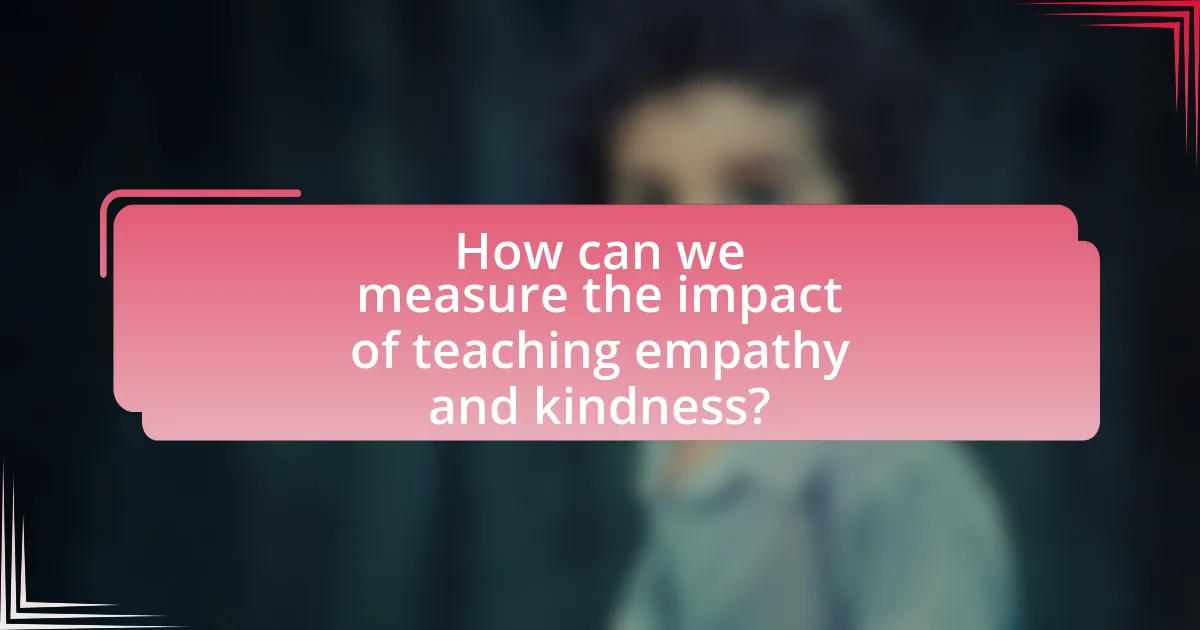
How can we measure the impact of teaching empathy and kindness?
The impact of teaching empathy and kindness can be measured through various quantitative and qualitative methods. Surveys and assessments can evaluate changes in students’ attitudes and behaviors towards peers, with tools like the Empathy Quotient and the Kindness Scale providing measurable data. Research indicates that programs focused on social-emotional learning, such as the Collaborative for Academic, Social, and Emotional Learning (CASEL), show significant improvements in students’ social skills and emotional well-being, with studies reporting a 23% increase in prosocial behaviors. Additionally, observational studies in classroom settings can track behavioral changes over time, providing concrete evidence of the effectiveness of empathy and kindness education.
What indicators show improvement in children’s empathetic behavior?
Indicators that show improvement in children’s empathetic behavior include increased prosocial actions, enhanced emotional recognition, and greater perspective-taking abilities. Research indicates that children who engage in activities promoting empathy, such as role-playing or cooperative games, demonstrate a higher frequency of helping behaviors and emotional support towards peers. For instance, a study published in the Journal of Child Psychology and Psychiatry found that children who participated in empathy training programs exhibited significant gains in their ability to identify and respond to the emotions of others, as measured by standardized assessments. Additionally, observational studies reveal that children displaying improved empathetic behavior often engage more in discussions about feelings and show a willingness to assist others in distress.
How can feedback from peers be used to assess empathy development?
Feedback from peers can be used to assess empathy development by providing insights into an individual’s ability to understand and respond to the emotions of others. Peer feedback often includes observations about how a person interacts in social situations, highlighting their capacity for perspective-taking and emotional resonance. Research indicates that peer evaluations can effectively capture social and emotional competencies, as peers are often more attuned to each other’s behaviors and emotional expressions than adults. For instance, studies show that peer assessments in educational settings correlate with self-reported empathy measures, validating their effectiveness in gauging empathy development.
What role do self-reflection and journaling play in measuring kindness?
Self-reflection and journaling serve as essential tools for measuring kindness by enabling individuals to assess their thoughts, feelings, and actions related to compassionate behavior. Through self-reflection, individuals can evaluate their interactions and identify moments of kindness or lack thereof, fostering greater awareness of their behavior. Journaling provides a structured way to document these reflections, allowing for tracking progress over time and recognizing patterns in kind actions. Research indicates that reflective practices can enhance emotional intelligence, which is closely linked to empathetic behavior and kindness, as shown in studies like “The Role of Self-Reflection in Emotional Intelligence” by Goleman (1995). This connection underscores the importance of self-reflection and journaling in cultivating and measuring kindness effectively.
What practical tips can help in teaching empathy and kindness effectively?
To teach empathy and kindness effectively, engage children in role-playing scenarios that allow them to experience different perspectives. Role-playing helps children understand emotions and reactions by putting themselves in someone else’s shoes, fostering a deeper emotional connection. Research indicates that children who participate in role-playing activities demonstrate increased empathy levels, as evidenced by a study published in the Journal of Educational Psychology, which found that such activities enhance emotional understanding and social skills. Additionally, encourage discussions about feelings and experiences, as open dialogue promotes emotional literacy and reinforces the importance of kindness in everyday interactions.
How can daily routines incorporate lessons on empathy and kindness?
Daily routines can incorporate lessons on empathy and kindness by integrating specific activities that promote understanding and compassion. For example, parents can set aside time each day for family discussions where everyone shares their feelings and experiences, fostering an environment of open communication. Research indicates that children who engage in regular discussions about emotions develop better emotional intelligence, which is crucial for empathy. Additionally, incorporating acts of kindness into daily tasks, such as helping a neighbor or volunteering, can teach children the importance of helping others. Studies show that children who participate in altruistic activities are more likely to exhibit empathetic behaviors. By consistently including these practices in daily routines, families can effectively nurture empathy and kindness in children.
What activities can families do together to reinforce these values?
Families can engage in activities such as volunteering together, practicing active listening during conversations, and participating in community service projects to reinforce values of empathy and kindness. Volunteering allows family members to experience the needs of others firsthand, fostering a sense of compassion. Active listening encourages understanding and respect for each other’s feelings, which is essential for developing empathy. Community service projects not only benefit those in need but also teach children the importance of kindness and social responsibility, as evidenced by studies showing that children who participate in such activities are more likely to exhibit prosocial behavior.







